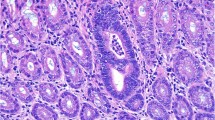Abstract
Experimental animal models of neoplastic diseases are important in understanding etiological and pathophysiological processes also in humans. In order to investigate whether the mechanism of genomic instability is associated with chemically induced colorectal tumorigenesis in rat we performed the following study: One hundred and fifty Wistar rats (males 220-280 g and females 140-180 g) were used in the study. Colorectal tumors were induced by means of 15 s.c. applications (20 mg/kg) of 1,2-dimethylhydrazine (DMH). On autopsy, all intestinal lesions were assessed by histological criteria used in human pathology. Forty five tumors were found in the large intestine - 30 of these in males and 15 in females, i.e. in 27% of all animals. In four animals multiple primary tumors were found. Histologically 24 tumours were adenocarcinomas, 14 signet-cell carcinoma and 7 adenomas. DNA was extracted from rat neoplastic lesions and adjoining microscopically normal tissues from the same slide and amplified by PCR, using 10 different microsatellite markers from chromosomes 1, 3, 5, 7 and 8. PCR amplicon were analyzed for microsatellite instability with non-isotopic method. In 13 adenocarcinomas (29%) microsatellite instability was found at a minimum of 1 locus. Seven tumors (15.5%) showed microsatellite instability at multiple loci. The results of our experiment suggest that genomic instability is an important molecular event in the pathophysiology of DMH induced colorectal carcinogenesis in rats.
Similar content being viewed by others
Author information
Authors and Affiliations
Additional information
Published: January 2000
Rights and permissions
About this article
Cite this article
Ravnik-Glavač, M., Cerar, A. & Glavač, D. Animal model in the study of colorectal carcinogenesis. Pflügers Arch 440 (Suppl 1), R055–R057 (2000). https://doi.org/10.1007/s004240000005
Published:
Issue Date:
DOI: https://doi.org/10.1007/s004240000005




